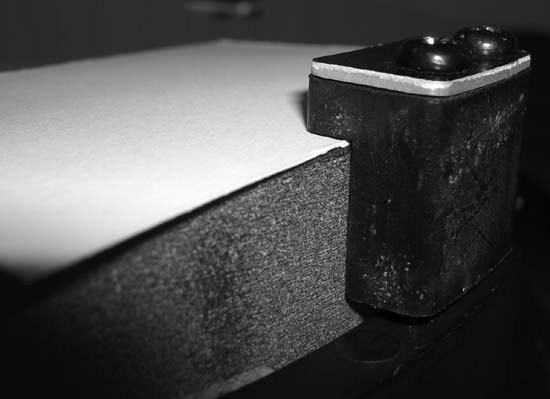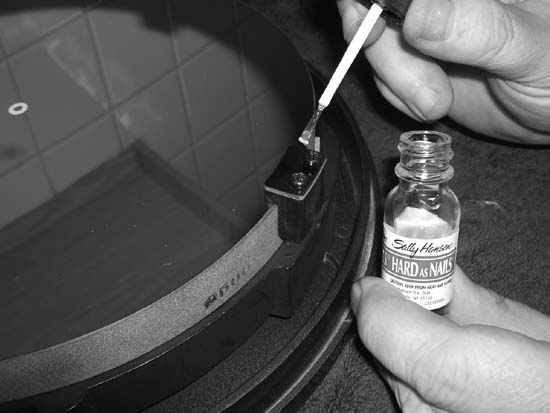Hack35.Eliminate Astigmatism
Hack 35. Eliminate Astigmatism
Pinching can turn good optics bad and your pinpoint stars into fuzzy lines. Astigmatism is an optical aberration that may be present in your eyes, in your telescope optics, or both. In a telescope that suffers from pure astigmatism, slightly defocusing a star image in one direction results in the circular star image becoming a short, straight line. Defocusing in the other direction yields another straight line, but oriented at 90° to the first line. Such pure on-axis astigmatism is rare; most telescopes that suffer from astigmatism also suffer from other aberrations and miscollimation, all of which can cause bewilderingly distorted images.
There are many possible causes of astigmatism, including your own eyes, a low quality eyepiece, a poorly figured primary mirror, a poorly supported primary mirror, a secondary mirror that is slightly spherical rather than flat, a mirror made from poorly annealed glass, and so on. But by far the most common cause of astigmatism in amateur telescopes is pinched optics. Fortunately, that's an easy problem to solve. The worst offenders are the ubiquitous Chinese and Taiwanese Newtonian reflectors and Dobs, which are sold under numerous brand names, including Orion, Skywatcher, Celestron, and many others. Many of these scopes use mirror clips to retain the primary mirror. The problem is that mirror clips aren't intended to lock the primary mirror into place, nor even to keep it from moving, but only to keep it from falling out of the mirror cell if the scope tube is pointed downward. But the Chinese and Taiwanese scope makers, apparently concerned about damage during the long trip across the Pacific Ocean, often torque down the mirror clips much too tightly. We've encountered some so tight we suspect they used an air wrench to tighten them. Although it seems unlikely that these soft rubber clips could deform a mirror no matter how great the pressure, even gentle pressure against the mirror is enough to distort it by a few millionths of an inch. That's more than enough to wreck image quality. To eliminate this most likely cause of astigmatism, pull the primary mirror cell from your scope and examine the mirror clips. If you've never touched them, you'll probably find they're screwed down tight and in full contact with the surface of the mirror. In fact, chances are good that the rubber mirror clips have actually adhered to your primary mirror. To fix the problem, remove the screws that secure each clip, being careful not to let the screwdriver or screws contact the primary mirror. Peel the clips off the mirror if necessary, and then reinstall the clips. Tighten the screws only far enough to retain the clips while leaving a slight gap between the surface of the mirror and the rubber. The mirror clips are not intended to clamp the mirror in place. Their only purpose is to keep the mirror from falling out of the cell. When the clips are adjusted properly, you should be able to slide a business card between the mirror and the rubber clip, as shown in Figure 3-7. Figure 3-7. Leave a small gap between the mirror clip and the mirror surface After you reinstall the mirror clips, use a small dab of nail polish or Loc-Tite on the head of each screw to make sure it stays put, as shown in Figure 3-8. The last thing you want is a loose screw falling onto your primary mirror and scratching it. Figure 3-8. Use nail polish or Loc-Tite to secure the mirror clip screws The secondary mirror is another possible source of astigmatism in a Newtonian reflector, albeit much less likely than tight primary clips. Actually, the secondary mirror itself is seldom the problem. Even in inexpensive scopes, the secondary mirror is generally close to being optically flat. The problem is the secondary mirror holder, which may bind the mirror, torquing it slightly out of flat. To eliminate this possible cause of astigmatism, remove the secondary holder and examine it to determine how the secondary mirror is secured.
Because of their physical designs, other types of telescope are less likely to be astigmatic than are Newts. Still, it's relatively common for a Chinese or Taiwanese refractor to suffer from pinched optics because its lens cell clamps the objective lens too tightly. This problem seems particularly common in 80mm and 90mm short-tube refractors. If you have such a refractor, check the lens cell to make sure the objective lens is not clamped too tightly. The objective lens should have enough slack to rattle slightly in the cell when you shake it. Lens cells vary, so we won't attempt to provide detailed instructions. Some lens cells are easily adjustable. Others are adjustable but require special tools. Still others aren't adjustable at all. Check the manual to determine if it is possible to adjust the cell. |
EAN: 2147483647
Pages: 112
